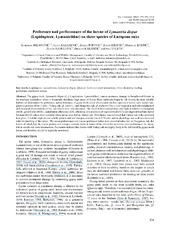Приказ основних података о документу
Preference and performance of the larvae of Lymantria dispar (Lepidoptera: Lymantriidae) on three species of European oaks
| dc.creator | Milanović, Slobodan | |
| dc.creator | Lazarević, Jelica | |
| dc.creator | Popović, Zorica | |
| dc.creator | Miletić, Zoran | |
| dc.creator | Kostić, Miroslav | |
| dc.creator | Radulović, Zlatan | |
| dc.creator | Karadžić, Dragan | |
| dc.creator | Vuleta, Ana | |
| dc.date.accessioned | 2020-11-04T10:47:47Z | |
| dc.date.available | 2020-11-04T10:47:47Z | |
| dc.date.issued | 2014 | |
| dc.identifier.issn | 1210-5759 | |
| dc.identifier.uri | https://radar.ibiss.bg.ac.rs/handle/123456789/3960 | |
| dc.description.abstract | The gypsy moth, Lymantria dispar (L.) (Lepidoptera: Lymantriidae), causes enormous damage to broadleaved forests in the northern hemisphere where it frequently defoliates large areas of forest. Since outbreaks begin in oak forests, its most suitable habitat, we determined the preference and performance of gypsy moth larvae when reared on three species of native oaks: sessile oak, Quercus petraea (Matt.) Liebl.; Turkey oak, Q. cerris L.; and Hungarian oak, Q. frainetto (Ten.). Leaf expansion and selected physical and chemical characteristics of the oak leaves were also measured. The shortest development time and highest relative consumption (RCR), growth rate (RGR), assimilation efficiency (AD), efficiency of conversion of ingested food (ECI) and digested food into larval biomass (ECD) values were recorded when larvae were fed on Turkey oak. Two-choice tests revealed that Turkey oak is the preferred host plant. It had the highest total soluble protein and leaf nitrogen content, lowest C/N ratio and its phenology was well synchronized with the hatching of the larvae. The worst performance and lowest preference index were recorded when fed on Hungarian oak, the leaves of which had the lowest protein and nitrogen content, while in terms of the values for preference and performance the larvae fed on sessile oak were intermediate. Our results indicate that forests with Turkey oak are highly likely to be defoliated by gypsy moth larvae and therefore should be regularly monitored. | en |
| dc.language.iso | en | sr |
| dc.publisher | Czech Academy of Sciences | sr |
| dc.relation | “Post- docs in the field of biological sciences at Mendel University” (CZ.1.07/2.3.00/30.0017) co- financed by the European Social Fund and the state budget of the Czech Republic | sr |
| dc.relation | info:eu-repo/grantAgreement/MESTD/Integrated and Interdisciplinary Research (IIR or III)/43007/RS// | sr |
| dc.rights | openAccess | sr |
| dc.rights.uri | https://creativecommons.org/licenses/by/4.0/ | |
| dc.source | European Journal of Entomology | sr |
| dc.subject | Lepidoptera | sr |
| dc.subject | Lymantriidae | sr |
| dc.subject | Lymantria dispar | sr |
| dc.subject | Quercus | sr |
| dc.subject | Herbivore-plant interactions | sr |
| dc.subject | Foliar chemistry | sr |
| dc.subject | Feeding preference | sr |
| dc.subject | Nutritional indices | sr |
| dc.title | Preference and performance of the larvae of Lymantria dispar (Lepidoptera: Lymantriidae) on three species of European oaks | en |
| dc.type | article | sr |
| dc.rights.license | BY | sr |
| dcterms.abstract | Вулета, Aна; Караджић, Драган; Радуловић, Златан; Костић, Мирослав; Милетић, Зоран; Поповић, Зорица; Лазаревић, Јелица; Милановић, Слободан; | |
| dc.rights.holder | © 2020 Institute of Entomology | sr |
| dc.citation.issue | 3 | |
| dc.citation.volume | 111 | |
| dc.identifier.doi | 10.14411/eje.2014.039 | |
| dc.identifier.scopus | 2-s2.0-84904668633 | |
| dc.identifier.wos | 000343664400009 | |
| dc.citation.spage | 371 | |
| dc.citation.epage | 378 | |
| dc.type.version | publishedVersion | sr |
| dc.identifier.fulltext | https://radar.ibiss.bg.ac.rs/bitstream/id/7563/Preference_and_performance_of_the_larvae.pdf | |
| dc.citation.rank | M22 |

